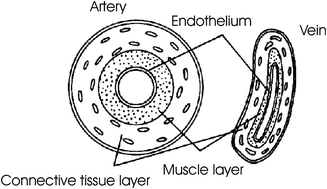Surface treatment of thin-film materials to allow dialogue between endothelial and smooth muscle cells and the effective inhibition of platelet activation
Abstract
This work aims to reproduce the structure of a blood vessel. The surface modifications that were carried out concerned the creation of an appropriate environment for communication between tissues. Cell–material interactions were studied in this work. Samples for examination were prepared on polished silicon substrates and the sample surface was covered with different biocompatible coatings such as: diamond like carbon (a-C:H), titanium (Ti), titanium nitride (Ti:N), titanium carbonitride (a-C:H:Ti:N), titanium oxide (Ti:O), silicon doped diamond like carbon (a-C:H:Si) and titanium doped diamond like carbon (a-C:H:Ti). Physical vapour deposition (hybrid pulsed laser deposition) was chosen for coating fabrication and the coating thickness ranged from 200 nm to 1 μm. Based on a dynamic analysis using blood, which considered aggregate formation, platelet consumption and blood platelet activation, the most haemocompatible coating was chosen. The study also considered channels for the migration of cells. Using the laser ablation method, migration channels were fabricated. The width of each individual channel depended on the cell size, which was close to 10–30 μm. Cells were deposited directly on the migration channels. An influence of the heat affected zone on cell proliferation was observed. Porous coatings were deposited as the next step after channel formation. The coatings were stabilized by a cross linking chemical reaction using 1-ethyl-3-(3-dimethylaminopropyl)carbodiimide and N-hydroxysuccinimide. Smooth muscle cells were deposited on the surface of samples without the porous coating, directly onto the migration channels. Human umbilical endothelial cells were deposited on the top of the synthetic porous coating. A de novo surface design for cardiovascular purposes with the function of providing oriented cell growth as well as allowing a dynamic dialogue between tissues was proposed.


 Please wait while we load your content...
Please wait while we load your content...